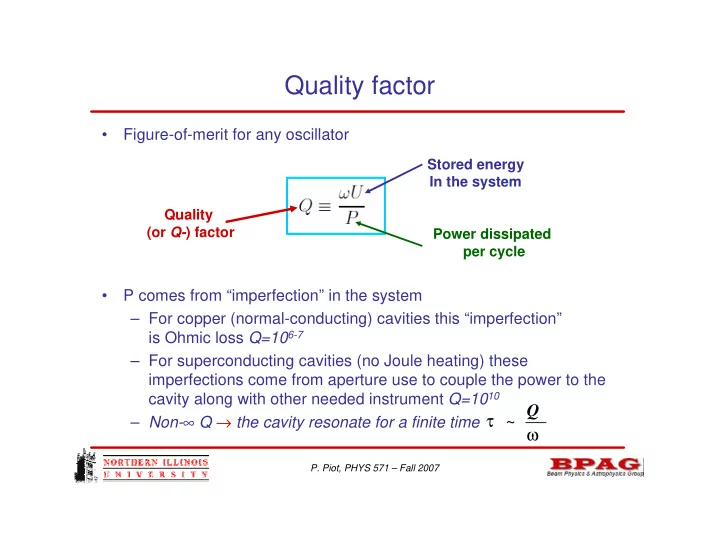

Quality factor • Figure-of-merit for any oscillator Stored energy In the system Quality (or Q- ) factor Power dissipated per cycle • P comes from “imperfection” in the system – For copper (normal-conducting) cavities this “imperfection” is Ohmic loss Q=10 6-7 – For superconducting cavities (no Joule heating) these imperfections come from aperture use to couple the power to the cavity along with other needed instrument Q=10 10 Q τ – Non- ∞ Q → the cavity resonate for a finite time ~ ω P. Piot, PHYS 571 – Fall 2007
Quality factor • Q is also representative of the system bandwidth ∆ ω 1 = ω Q • Same as in RLC circuits P. Piot, PHYS 571 – Fall 2007
Q for TM mode The quality factor writes • or P. Piot, PHYS 571 – Fall 2007
Q for TE mode ⇒ P. Piot, PHYS 571 – Fall 2007
Q for TE mode P. Piot, PHYS 571 – Fall 2007
Comparison with JDJ’s notations • Note on shunt impedance (these Notes) (JDJ) • Q -factor notations (JDJ) (from these Notes) P. Piot, PHYS 571 – Fall 2007
Comparison with JDJ’s notations • The Geometric factor P. Piot, PHYS 571 – Fall 2007
Comparison with JDJ’s notations • Example of TE 111 mode Same as JDJ 8.97 P. Piot, PHYS 571 – Fall 2007
Cavity perturbation & Slater’s theorem I Consider a volume V bounded by the surface S the force on the S • due to the e.m. field present in V is computed from the Maxwell’s stress tensor via • With and • Introducing the displacement • The work done by the e.m. field against the displacement is P. Piot, PHYS 571 – Fall 2007
Cavity perturbation & Slater’s theorem II • Note the quantity is a pressure (see your PHYS 563) since at the conductor boundary we have • So • Time-averaging gives P. Piot, PHYS 571 – Fall 2007
Cavity perturbation & Slater’s theorem III • Consider the TM010 mode (“famous” mode in accelerators) at r=0 • Compute the frequency shift associated to a small object at r=0, z By measuring δω/ω as the small object is moved along z we can reconstruct the z- dependence of E z P. Piot, PHYS 571 – Fall 2007
Slater’s theorem: example of application • Example of real measurement [ Brown et al . PRSTAB 4 083501 ] move z=20 mm Bead pull Iris z=0 mm P. Piot, PHYS 571 – Fall 2007
Recommend
More recommend